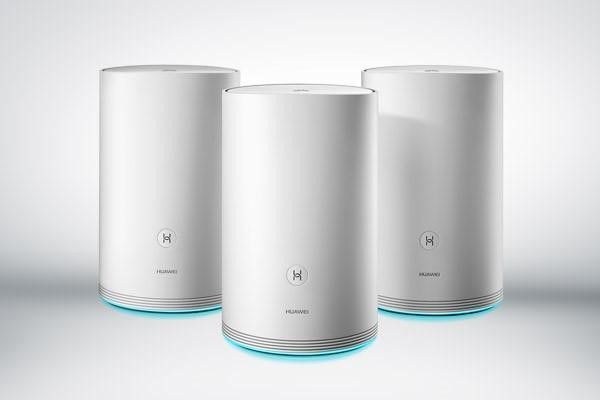By Jean-Jacques DeLisle, contributing writer
To implement previous Wi-Fi systems throughout a whole home with the expectation of high throughput and seamless coverage, a user essentially needed the skills of a networking engineer. These systems were also expensive, as industry-grade hardware was often required and the setup complexity was high. Wi-Fi systems have evolved over the past few years, such as Google’s OnHub and mesh Wi-Fi routers, which enable advanced wired and wireless networking features at reasonable prices and with semi-automated setup. At CES 2018, Huawei announced a whole-home Wi-Fi system, the HUAWEI WiFi Q2, which takes this concept to the next level.

The HUAWEI WiFi Q2 was revealed at CES 2018 and promises a whole-home Wi-Fi solution with mesh Wi-Fi and power-line communications capability. Image source: Huawei.
The first question to answer addresses the need for more sophisticated Wi-Fi systems. For many homes and apartments, a simple Wi-Fi router may be more than adequate. However, just plugging in a Wi-Fi router won’t address all homes, and in many large or oddly shaped homes, there are spots of low throughput or signal strength that limit utility. This is a problem as the adoption of smart home technologies is increasing, and a strong Wi-Fi network is the backbone of many of these new solutions. So a strong and seamless Wi-Fi connection is needed, at virtually every corner of a house, for the latest smart home technology.
Wiring a home for a Wi-Fi system has always been an expensive and sometimes complicated solution. Power-line communications (PLC) technologies exist that can leverage a home’s electrical power wiring as a conduit for high-throughput networking traffic, and these have become an attractive alternative for people who find rewiring a home too expensive or rent and can’t wire a home. The crux is that the standard Ethernet routers, Wi-Fi routers, and PLC technologies would all have to be combined and set up to create a seamless system. Traditionally, this takes many different components and connections and is probably beyond the ability of most people.
“We are streaming more content than ever before — more music, more movies, and more social media — on more connected devices, which makes fast and reliable Wi-Fi an essential need,” said Richard Yu, CEO of the Huawei Consumer Business Group. Adding another aspect to Yu’s statement, the older Wi-Fi and home networking systems, though sometimes offering enterprise-grade performance, have had significant drawbacks in the security department. As more people are using their home internet for banking, file sharing, insurance, and other financial and legal applications, security of a home network is an even bigger concern than before.
This is where the vision for HUAWEI’s WiFi Q2 comes in. Designed for larger homes, estates, and possibly even small businesses, the WiFi Q2 system is actually a fusion of several in-home networking technologies, including Ethernet router, Wi-Fi router, a PLC system, and enhanced home networking security. This means that a novice user could setup a whole home Wi-Fi system, which is secure, and expand that system as the need arises. The hybrid mesh and PLC networking of the WiFi Q2 is described as hitting speeds up to 1,876 Mbps and is capable of 100-ms switching time between nodes. Essentially, these features should provide seamless streaming of HD video content anywhere in a home, even on the move.
Beyond Huawei’s accomplishments, emergence of these types of products are signaling a growing consumer interest in smart home technology, home automation, and a growing dependence on personal connected devices. As this trend grows, more technologies, such as wireless power transfer and home sensing systems, are likely to finally be adopted. Also, as these technologies emerge, it’s likely that products will continue to have more functional integration, like with smartphones and TVs.
Advertisement
Learn more about Electronic Products Magazine





